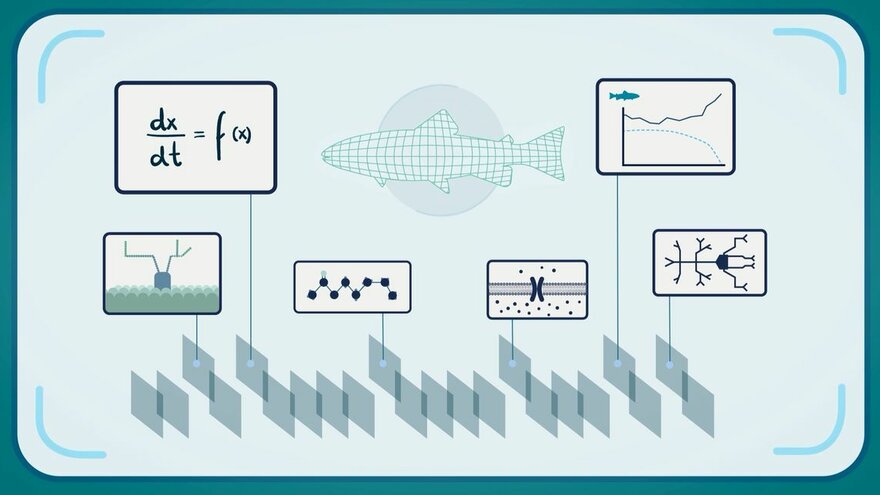A new consortium of industry, researchers, and innovators will further develop a knowledge base with digital models of the salmon’s body. This can lead to more sustainable aquaculture in the future.
Original article in Norwegian by Hilde Zwaig Kolstad and Kristine Løwe. Translation by Sari C. Cunningham
"Data can become more valuable when it is shared. By using mathematical models to learn from each other’s experience, we can more quickly answer the challenges industry faces," explains Jon Olav Vik, project leader of the DigiSal research project.
He invited colleagues from the aquaculture industry, research institutions, Innovation Norway, the Norwegian Research Council, NMBU’s Technology Transfer Office, Seafood Cluster, and the Centre for Digital Life Norway (DLN) to a start-up workshop in Ski from June 5th-6th.
Agreed common goal to obtain knowledge on salmon biology
The arrangement resulted in a working group consisting of industry, university researchers, and innovators, with the Norwegian Research Council acting as observer.
Their common vision is to work on a shared knowledge base of data and mathematical models of salmon biology, called the Digital Salmon (DigiSal).
More sustainable salmon feed
Today, farmed salmon receive 75% of their fat and protein requirements from plant-based feed.
However, researchers at NMBU are now testing to see if we can feed salmon ingredients that come from grass, spruce trees, seaweed and algae – food not meant for human consumption. Feed experiments are being conducted by Foods of Norway, and the data generated is being analyzed by DigiSal researchers. In the DigiSal project they are working on a model that will let us calculate what farmed salmon can and should eat.
The goal for digitalizing the salmon body is to create a library of different models of life processes in the body, in order to combine these in tailored data simulations. These simulations will let us calculate the best way to use resources – both when thinking about food security and the health and welfare of fish and humans.

"The dream scenario is if we can use mathematical models to calculate which salmon feed ingredients lead to a good, healthy and competitive product. We want to replace today’s "trial and error" experimentation with a workflow where most of the "mistakes" are made in a computer, and only feed ingredients selected by the model will be tested out in practice. This will save both money and time," Vik explains.
During the workshop in Ski, leaders from the various sectors spoke about the use of data streams to create value in mariculture, how one can achieve data and model security, the potential role of the Norwegian Research Council, and the DigiSal project in light of "the digital patient", a similar project in medical systems biology.
The start of an important collaboration
The underlying basis behind the initiative is the fact that mathematical models of biological processes are necessary in order to efficiently utilize the enormous amount of available data in the research and development projects in the mariculture sector. By connecting data together, a combined sector can more easily integrate old and new knowledge.
"This was a very good start to something I believe can become an encompassing and long-term partnership. With time I hope this will also develop into an interdisciplinary field – connecting academia, industry, and public actors together – better able to meet the new challenges that arise in salmon aquaculture and mariculture. For example, challenges in connection to fish feed, fish health, and climate changes," summarizes Vik.
Read the whole story on the Centre for Digital Life Norway
The Centre for Digital Life Norway is a virtual and national center that will maximize the usage of biotechnology across research disciplines.
NMBU is involved in four of the research projects that are part of the center, including DigiSal which is led by NMBU. The focus of DigiSal is to establish a mathematical model for farmed salmon, or more accurately a collection of models. These models will form a useful tool which could be used to predict the effects of different feed compositions, for example. Watch the following video to understand the project better:
NMBU also leads the Digital Life project "OXYMOD – Optimized oxidative enzyme systems for efficient conversion of lignocellulose to valuable products", and work packages in the Digital Life projects "DigiBrain: From genes to brain function in health and disease" and "dCod 1.0: decoding systems toxicology of cod (Gadus morhua)".
Facts
The interdisciplinary research project "DigiSal. Towards the Digital Salmon: From a reactive to a pre-emptive research strategy in aquaculture" was funded by the Research Council of Norway's BIOTEK2021 in the first phase of the Centre for Digital Life Norway. The project will continue through 2021.
The project is led by NMBU, with collaborating researchers at four different faculties.
The research partners are the universities in Trondheim, Bergen, Tromsø, Stirling (Scotland) and Wageningen (the Netherlands), as well as the Institute of Marine Research in Bergen. The industry partners are AquaGen (salmon breeding company) and EWOS (feed manufacturer).
